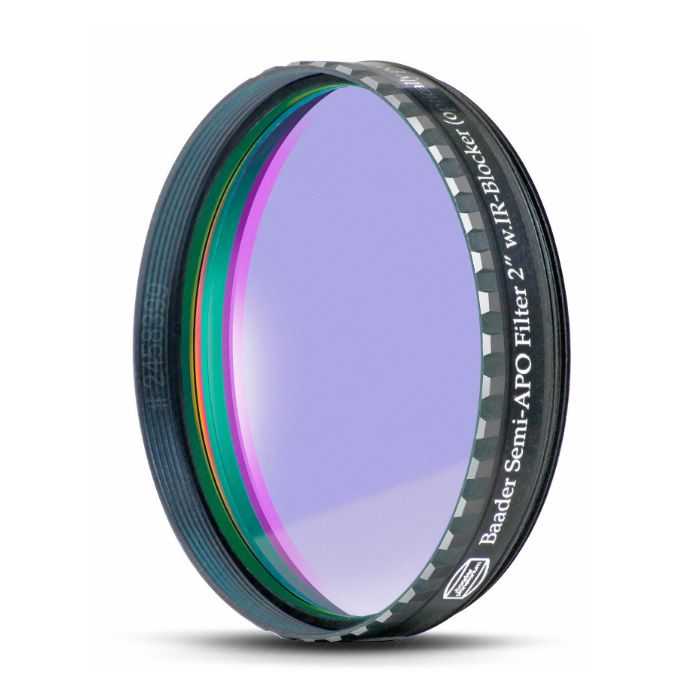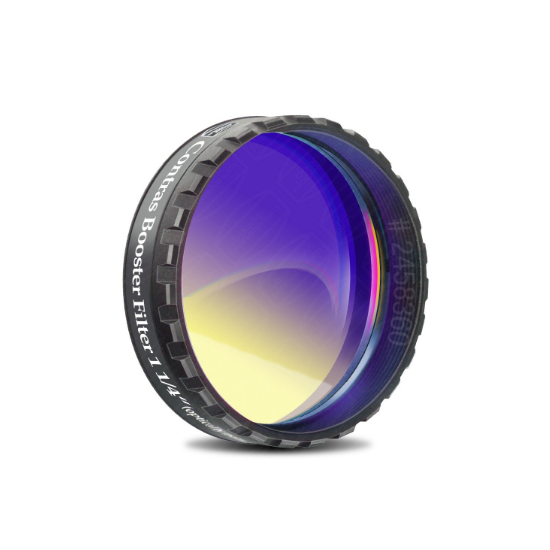
Optical correction filters increase vision and picture quality by balancing colors, increasing contrast, or decreasing light wavelengths. They are instrumental in astronomy because they reduce atmospheric distortion and enhance planetary details. Urban residents struggle with light pollution. Sodium, mercury, and LED lamps illuminate the night sky, making it impossible to see details. The Optolong L-Para 2" Filter helps in broadband targets and works with modified and unmodified cameras.
Highlighted Products
Featured Product 1
The Optolong Moon & Skyglow Filter boosts your visual and photographic experiences by providing a darker background sky and increasing the contrast between celestial objects and the sky. Produced from Schott glass using advanced ion-assisted deposition technology, this product boasts a 45mm clear aperture constructed from lightweight, durable metal.
Featured Product 2
Is it possible to use this filter with Baader Astro for sun observations, Jupiter, Mars, and cloud bands? The Baader 1.25-inch Contrast Booster Telescope Filter helps clear achromatic refractors of blue defocused haze. Integrating a proprietary Neodymium glass melt with a 23-layer dielectric long-pass blocker and a 7-layer ultra-low antireflection coating achieves transmission efficiencies of over 95% throughout selected regions of the visible spectrum.
Featured Product 3
One essential tool for making professional-grade final products is the Astronomik UV-IR Blocking Luminance Filter. It can handle many photons because of its wide spectral bandpass and high transmission. A broad spectral bandpass could make stars look bloated or softer; flawless color correction isn't always possible. This can be mitigated by using a somewhat narrower spectral window.
More About This Category
You've just purchased a nice fast focal ratio refractor and are blown away by its incredibly sharp and high contrast views of large nebulae and clusters, however, the moon is up tonight and you want to see what this baby can do. Inserting a high power eyepiece into its focuser and tweaking the fine focus to perfection, you are horrified at the amount of false color that you see. If this is you, then you need to check out more details about correction filters.
Understanding Correction Filters in Astronomy
Astronomy has long captivated those seeking to discover the mysteries beyond our world. Both observers are content to view the heavens with their eyes, and photographers aiming to capture cosmic scenes benefit greatly from having proper tools. The correction filter is essential for every astronomer, whether looking up or through a lens. These filters enhance the experience for visual gazers and astrophotographers by refining the views and photographs obtained, yielding clearer glimpses of the expansive universe above. While filters play a key role in astronomical pursuits, the true thrill comes from the exploration itself and gaining a deeper understanding of the majestic cosmos that calls to our innate human curiosity.
What Are Correction Filters?
Correction filters are specialized optical filters designed to enhance the observational experience by reducing undesirable effects, including overbearing luminance and misleading hues. They prove particularly useful when scrutinizing luminous celestial bodies similar to the Moon or when deploying telescopes that can induce chromatic aberration, which is the distortion and blending of wavelengths. This phenomenon is predominantly prevalent in fast focal ratio refractors, celebrated for their crystal clear and high-contrast renderings of ethereal objects. Additionally, these filters offset chromatic aberration in telescopes with fast focal ratios by lessening the separation of colors at the periphery of images. While correction filters optimize sightseeing experiences, some astronomers argue that chromatic defects add character when studying astronomical marvels.
The Importance of Correction Filters
Imagine you've procured a quick compound refractor telescope. You assemble it, add a high-magnification eyepiece, and eagerly focus on the Moon. However, instead of the stunning perspective you expected, you are confronted with a distracting halo of artificial hue around the lunar surface. This is where modifying filters enter the scenario. They can help mitigate these issues, letting you appreciate more precise and more vivid perspectives of celestial objects.

An outstanding choice for addressing chromatic aberration is the Baader Planetarium's 2-inch Semi-APO Filter. This advanced filter reduces the contrast-stealing effects of artificial color in non-APO refractors. By using this filter, you can restore the quality of your perspectives, making them more pleasant and accurate to reality.
Enhancing Deep-Sky Observations
In addition to correcting false colors, filters can emphasize the distinction of faraway celestial objects such as nebulae and galaxies. For those passionate about seeing astronomical sights visually, the Explore Scientific line of 1.25-inch and 2-inch CLS filters provide outstanding alternatives. These filters are engineered better to reveal an extensive assortment of faint sky items while offering a naturally appearing background context. Unlike narrowband filters, which are inclined to generate extraordinary contrast, CLS filters aid in preserving a balanced perspective of the starry firmament. Meanwhile, some brief but complex nebulae challenged even seasoned astronomers of that time, their wispy forms only partially discernible against a backdrop laden with stars.

Light pollution plagues many amateur astronomers across cities, large and small. Urban centers flood the night with an unnatural radiance that washes faint phenomena from the firmament. However, a CLS filter can meaningfully reduce the ravages of artificial illumination, restoring many shrouded mysteries to view. Nebulae no longer blur their wisps and swirls, regaining definition, while far galaxies once more shine through the washed-out night. Frustrations evaporate as darkness descends anew, the filtered photons parting veils to unveil vistas obscured. The CLS filtering selectively blocks specific wavelengths that streetlamps and storefronts spread while permitting the natural effulgence of celestial objects to shine through unimpeded. Grandeur is excellent, and small stands are revealed under such dark and clarified skies.
Choosing the Right Filter
When selecting a correction filter, one must consider the instrument used, and precisely which issues require addressing. For example, if mainly observing Earth's sole natural satellite or planets afflicted by chromatic aberration, the Baader Planetarium’s 2-inch Semi-APO Filter would prove beneficial. Alternatively, the Explore Scientific CLS filters would greatly complement your gear by focusing on faint celestial objects amidst urbanized regions shrouded in artificial light.
Filters come in various diameters, necessitating selecting a model compatible with your eyepiece or optical tube. Numerous observers find that maintaining an assortment of filters permits adapting to changing environmental conditions and subjects of interest, substantially enhancing the viewing experience. Maintaining such a quiver allows readily compensating for aberrations to maximize the details gleaned from imposing and obscure targets.
Correction filters are invaluable assets for visual observers and astrophotographers alike. They can dramatically enhance the caliber of one's perspectives by reducing unintended consequences such as artificial tinting and luminescence contamination. Whether investigating the lunar depressions or the intricate subtleties of far-off galactic clusters, employing the suitable filter can rework one's stargazing. Therefore, do not allow luminescence contamination or optical distortions to diminish your pleasure in the nighttime celestial sphere—invest in a high-quality corrective filter and rediscover the splendor of the universe in all its vast wonder!


